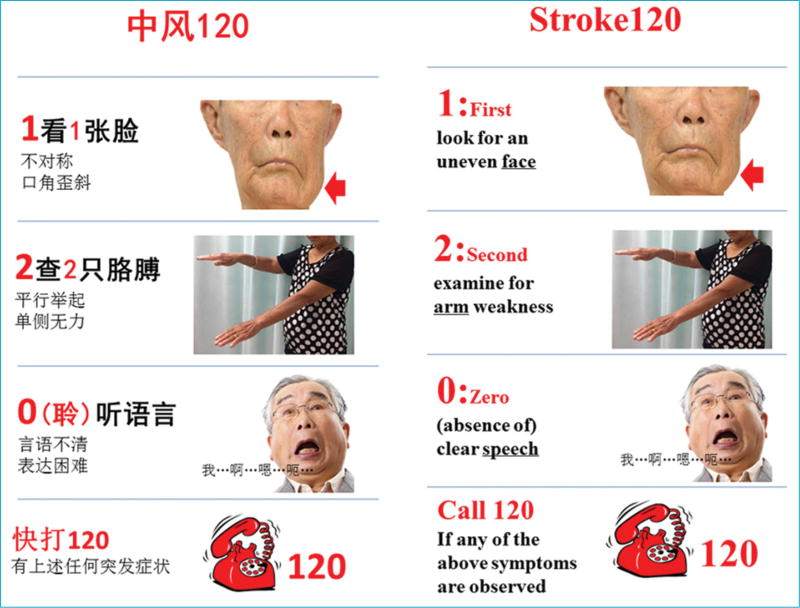In China, the incidence of stroke is higher than in many other countries.1 Although stroke is a devastating disease that can result in lifelong disability or death, these outcomes could potentially be prevented if treatment is initiated quickly. However, prehospital delays are common. In a study in 62 hospitals in 37 cities across China,2 the median time of prehospital delay was 15·0 h (IQR 2·8–51·0). A study in western urban China1 suggested that only 17% of stroke patients knew the initial symptoms of a stroke, only 19% used emergency medical services, and about 33% of the stroke cases were not correctly diagnosed by ambulance physicians. These data clearly show that education programmes are urgently needed to facilitate early identification of stroke and rapid medical response.
To address this need in the USA, the mnemonic FAST (face, arm, speech, time) was created as an educational tool in 2007.3, 4 Since then, various stroke educational programmes using FAST as a model have been developed. Although stroke education in China is crucial, neither direct use of FAST nor simple translation of the acronym into Chinese will work well due to language barriers. Thus, we propose our model “Stroke 1-2-0” as a novel educational strategy suitable for China.
We suggest that the medical emergency telephone number 120, can be adapted as a convenient mnemonic tool for rapid stroke recognition in Chinese (figure). These numbers are transformed into three stroke recognition actions, where 1 represents “First, look for an uneven face,” 2 represents “Second, examine for arm weakness”, and 0 represents “Zero (absence of) clear speech”. In the Chinese version, the pronunciation of zero is “ling”, which has the same meaning of “ting” (hearing). If stroke is suspected or identified through this three-step observation, the emergency number 120 must be dialled. The use of Stroke 120 as a mnemonic tool links stroke identification with the emergency service telephone number, and can be easily remembered even by those with minimal education.
Figure. Stroke 1-2-0 for China.
Left panel: Chinese version. Right panel: translated English version with the key messages. Image sources: Adobe Stock Image (first image), Shutterstock (third image), and Free Click Art (fourth image).
We are currently planning to validate this novel strategy in China. Through this validation, we hope that a final programme suitable for national implementation in China could be developed to reduce prehospital delay and improve outcome for patients with stroke.
Acknowledgments
Funding information: NSF of China (81572232, JZ); NIH R01 (1RO1GM111421, RL).
Footnotes
We declare no competing interests.
References
- 1.Jiang B, Ru X, Sun H, et al. Pre-hospital delay and its associated factors in first-ever stroke registered in communities from three cities in China. Sci Rep. 2016;6:29795. doi: 10.1038/srep29795. [DOI] [PMC free article] [PubMed] [Google Scholar]
- 2.Jin H, Zhu S, Wei JW, et al. Factors associated with prehospital delays in the presentation of acute stroke in urban China. Stroke. 2012;43:362–70. doi: 10.1161/STROKEAHA.111.623512. [DOI] [PubMed] [Google Scholar]
- 3.Hodgson CS. To FAST or not to FAST? Stroke. 2007;38:2631–32. doi: 10.1161/STROKEAHA.107.488809. [DOI] [PubMed] [Google Scholar]
- 4.Kleindorfer DO, Miller R, Moomaw CJ, et al. Designing a message for public education regarding stroke: does FAST capture enough stroke? Stroke. 2007;38:2864–68. doi: 10.1161/STROKEAHA.107.484329. [DOI] [PubMed] [Google Scholar]



